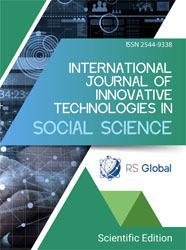THE MOTIVATIONAL IMPACT OF AUGMENTED REALITY ON ARCHITECTURE STUDENTS: A FIELD STUDY AT AN INTERNATIONAL EXHIBITION
Abstract
This study aimed to evaluate the effectiveness of augmented reality technology in motivating architectural engineering students and improving their comprehension of complex projects. An AR- application called "builtec" was developed, displaying two architectural models: an exterior view of the building and its surroundings, and an interior view showing the internal details of one floor. The study adopted an experimental analytical approach, conducting the experiment using modern digital and tablet devices on a sample of 81 students during an international exhibition held in Algeria in 2024. Results showed significant success of the technology, with the attractiveness of the experience receiving a strong approval rate of 95%, interaction with the virtual model achieving 86% approval, and ease of technology use reaching 82%, along with positive technical aspects evaluation at 92%. The study concluded by demonstrating the effectiveness of augmented reality technology as a means to increase interaction, motivation, and enhance architecture students' understanding of complex projects. The study recommends expanding the use of augmented reality technology in educational curricula and conducting more comparative studies covering various architectural presentation techniques to identify the best technologies and practices in architectural education.
References
Azuma, R. T. (1997). A survey of augmented reality. Presence: Teleoperators & Virtual Environments, 6(4), 355-385. https://doi.org/10.1162/pres.1997.6.4.355
Billinghurst, M., Clark, A., & Lee, G. (2015). A survey of augmented reality. Foundations and Trends® in Human–Computer Interaction, 8(2-3), 73-272. https://doi.org/10.1561/1100000049
César González Mariño, J. (2009). TIC y la transformación de la práctica educativa en el contexto de las sociedades del conocimiento. https://doi.org/10.7238/rusc.v6i2.89
Larsen, Y., Bogner, F., Buchholz, H., & Brosda, C. (2011). Evaluation of a portable and interactive augmented reality learning system by teachers and students. Open Classroom Conference Augmented Reality in Education, 41-50. https://doi.org/10.1109/ICALT.2011.111
Noghabaei, M., Heydarian, A., Balali, V., & Han, K. (2020). A Survey Study to Understand Industry Vision for Virtual and Augmented Reality Applications in Design and Construction. https://doi.org/10.1061/9780784482865.036
Poghosyan, S. (2019). Section 9. Pedagogy LEARNING-ORIENTED AUGMENTED REALITY TECHNOLOGY. ResearchGate.
Shaghaghian, Z., Burte, H., Song, D., & Yan, W. (2021). Learning Geometric Transformations for Parametric Design: An Augmented Reality (AR)-Powered Approach. https://doi.org/10.1007/978-3-030-77000-8_18
Yao, S. (2018). Teaching structural analysis with a mobile augmented reality application Design
Yazdani, S. & Rashidi Mohammadi, A. (2013). Teaching Architectural design.
Carmigniani, J., & Furht, B. (2011). Augmented Reality: An Overview. In B. Furht (Ed.), Handbook of Augmented Reality (pp. 3-46).
Views:
44
Downloads:
27
Copyright (c) 2024 Amokrane Radhwane, Gherzouli Lazhar, Atef Ahriz, Lousfane Selma

This work is licensed under a Creative Commons Attribution 4.0 International License.
All articles are published in open-access and licensed under a Creative Commons Attribution 4.0 International License (CC BY 4.0). Hence, authors retain copyright to the content of the articles.
CC BY 4.0 License allows content to be copied, adapted, displayed, distributed, re-published or otherwise re-used for any purpose including for adaptation and commercial use provided the content is attributed.















